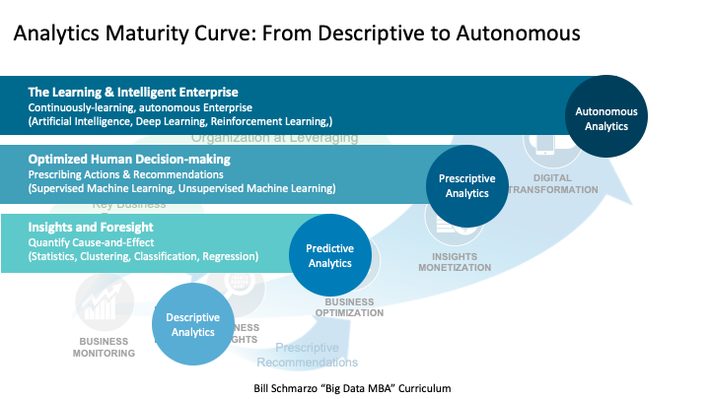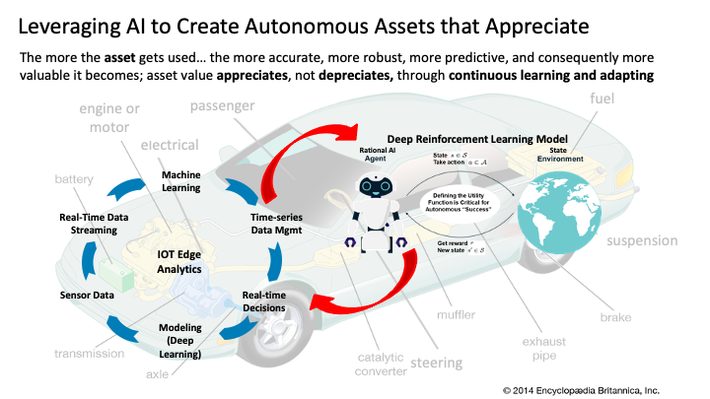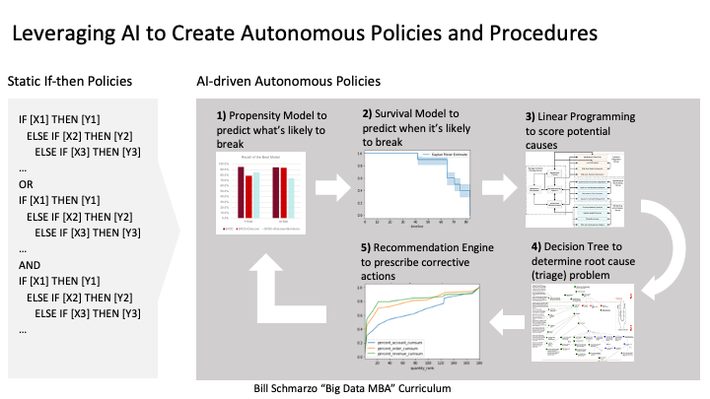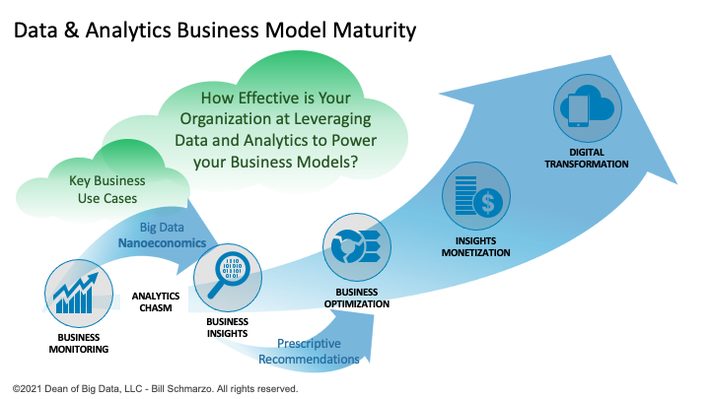
In Chapter 8 of my new book “The Economics of Data, Analytics, and Digitalization Transformation”, I discuss the 8 Laws of Digital Transformation. My goal for chapter 8 was to push folks out of their comfort zones, especially with respect to how they are defining Digital Transformation success. Why? Because too many folks don’t really understand Digital Transformation. For example, from the Forbes article “100 Stats On Digital Transformation And Customer Experience”, we get the following factoid:
21% of companies think they’ve already completed digital transformation
To that factoid, I say BS! I think those 21% of companies are confusing Digitalization with Digital Transformation. Digitalization is the conversion of human-centric analog tasks into digital capabilities. For example, digitalization is replacing human meter readers, who manually record home electricity consumption data monthly, with internet-enabled meter readers that send a continuous stream of electricity consumption data to the utility company.
But Digital Transformation is something bigger, harder, and much more valuable:
Digital Transformation is where organizations have created a continuously learning and adapting culture, both AI-driven and human-empowered, that seeks to optimize AI-Human interactions to identify, codify, and operationalize actionable customer, product, and operational insights to optimize operational efficiency, reinvent value creation processes, mitigate new operational and compliance risk, and continuously create new revenue opportunities.
Digital Transformation is about predicting what’s likely to happen, prescribing recommended actions and continuously-learning and adapting (autonomous) faster than your competition.
From Descriptive to Autonomous Analytics
Digital Transformation is about creating an organization that continuously explores, learns, adapts, and re-learns. Wash, rinse, repeat. Every customer engagement is an opportunity to learn more about the preferences and behaviors of that customer. Every product interaction or usage is an opportunity to learn more about the performance and behaviors of that product. Every employee, supplier and partner engagement provide an opportunity to learn more about the effectiveness and efficiencies of your business operations.
To create a continuously learning intelligent organization, organizations need to master the transition from reporting to predicting to prescribing to autonomous analytics. Now I know that most analytics maturity models stop at prescriptive analytics (descriptive to predictive to prescriptive), but that’s old school thinking. The world is changing, and the new analytics maturity goal is autonomous analytics (Figure 1).

Figure 1: Analytics Maturity Curve: From Descriptive to Autonomous Analytics
This Analytics Maturation Curve provides a guide to help organizations transition through the three levels of analytics maturity from reporting to autonomous:
- Level 1: Insights and Foresight. This is the foundational level of advanced analytics. Level 1 includes statistical analysis, data mining, and descriptive and exploratory analytics (e.g., clustering, classification, regression) to quantify cause-and-effect, determine confidence levels, and measure goodness of fit with respect to the predictive insights.
- Level 2: Optimized Human-decision Making. The second level of advanced analytics seeks to uncover and quantify the customer, product, and operational insights (predicted behavioral and performance propensities) buried in the data. Level 2 leverages Predictive and Prescriptive analytics that can uncover and codify individualized trends, patterns, and relationships; determine the root causes of the trends, patterns and relationships, and deliver dynamic, prescriptive recommendations and actions.
- Level 3: The Learning and Intelligent Enterprise. The third level of advanced analytics includes artificial intelligence, reinforcement learning and deep learning/neural networks. Level 3 leverages Autonomous analytics that continuously learn and adapt with minimal human intervention. These analytics seek to model the world around them based upon the objectives as defined in the AI Utility Function by continuously taking action, learning from that action, and adjusting the next action based upon the feedback from the previous action. Think of this as a giant game of “Hotter and Colder” where the analytics are continuously learning from each action and adjusting based upon the effectiveness of that action with respect to the operational goals (maximize rewards while minimizing costs) with minimal human intervention.
Understanding Autonomous Use Cases
There are a couple of different ways or uses cases for exploiting autonomous analytics. One is the creation of autonomous devices and the other is the creation of autonomous processes. Let’s review each.
Use Case #1: Autonomous Devices
Okay, I have certainly beaten this topic to death, but it bears repeating because it is such a game changer for any organization that sells products (or products as a service). Tesla is exploiting its ever-growing body of operational and driving data to continuously train the autonomous Tesla Artificial Intelligence-based Full Self-Driving (FSD) brain powers the Tesla semi-autonomous car. Tesla mines this data to uncover and codify operator, product, and operational insights then get propagated back to each individual car resulting in continuously-refining and adapting capabilities such passing cars on the highway, navigating to the off ramp, maneuvering around traffic accidents and debris on the roads, and parking.
Tesla autonomous cars are exploiting the capabilities of AI to create continuously learning autonomous cars that get more reliable, more efficient, safer, more intelligent, and consequently more valuable through usage with minimal human intervention (Figure 2).
Figure 2: How AI is Creating Autonomous Devices
Tesla is not alone in building autonomous products. John Deere is building autonomous farm tractors, Caterpillar is building autonomous construction equipment, and Nuro is building autonomous delivery vehicles because you gotta get that pizza delivered on time. Heck, one can’t be considered a serious industrial company if you don’t have a plan for creating autonomous products.
Use Case #2: Autonomous Policies
As operations become more complicated and more real-time, it’s becoming harder for organizations to ensure that their operating policies and procedures are evolving as fast as their business and operating environments. Digitalization provides a golden opportunity to improve operational effectiveness by replacing human-centric analog tasks with digital capabilities. That not only reduces human time and expense but allows organizations to capture more real-time, granular data about customer usage patterns and product performance characteristics.
This is the perfect time for leveraging AI to create autonomous policies, and procedures that can evolve at the speed of the business with minimal human intervention. This evolution to autonomous policies and procedures starts by replacing code-based procedures and policies with AI-based learning-based procedures and policies (Figure 3).

Figure 3: Leverage AI to Create Autonomous Policies
Using AI, we can transition from static policies to autonomous policies that learn how to map any given situation (or state) to an action to reach a desired goal or objective with minimal human intervention. These autonomous policies would dynamically learn and update in response to constantly changing environmental factors (such as changes in weather patterns, economic conditions, price of commodities, trade and deficit balances, global GDP growth, student debt levels, fashion trends, Cubs winning the World Series, etc.).
Embracing Autonomous to Address Decision Bias and Discrimination
Autonomous policies and procedures not only can ensure that the organization is making informed business and operational decisions, but can also combat bias, prejudice, and discrimination in making decisions. For example, Malcolm Gladwell’s “Talking to Strangers” highlights how AI-informed decisions can lead to equitable decisions in the judicial system.
Economist Sendhil Mullainathan examined 554,689 bail hearings conducted by judges in New York City between 2008 and 2013. Of the more than 400,000 people released, over 40% either failed to appear at their subsequent trials or were arrested for another crime. Mullainathan applied an ML program to the raw data available to the judges and the computer made decisions on whom to detain or release that would have resulted in 25% fewer crimes.
However, AI-driven policy decisions have their own challenges. As I discussed in “Ethical AI, Monetizing False Negatives and Growing Total Addressable Market”, AI model confirmation bias is the tendency for an AI model to identify, interpret, and present recommendations in a way that confirms the AI model’s preexisting assumptions. AI model confirmation bias feeds upon itself, creating an echo chamber effect with respect to the biased data that continuously feeds the AI models. Overcoming AI model confirmation bias starts by 1) understanding the costs associated with False Positives and False Negatives and 2) building a feedback loop where the AI model can continuously-learn and adapt from the False Positives and False Negatives.
From Descriptive to Autonomous Summary
Transitioning from Descriptive to Autonomous analytics is a game-changer but must be framed against the Data & Analytics Business Maturity Index to help organizations become more effective at leveraging data and analytics to power their business (Figure 4).

Figure 4: Data & Analytics Business Maturity Index
By the way, Jeff Frick does a marvelous job grilling me on the 8 Laws of Digital Transformation. The video is a lot more interesting than this blog. So, grab some Cap’n Crunch and enjoy the conversation!

